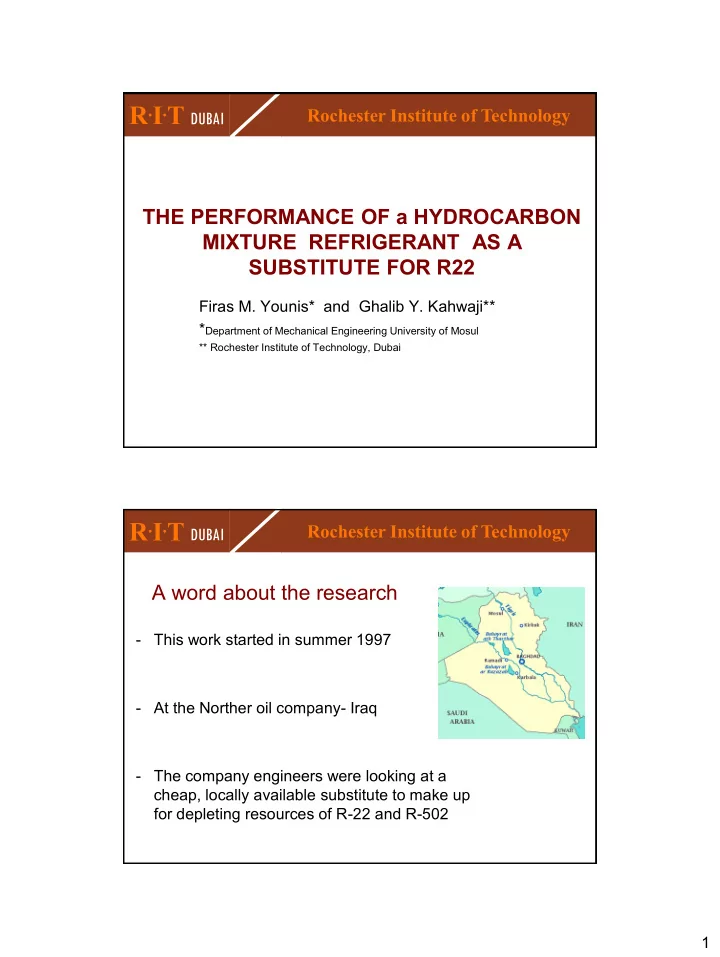

R . I . T DUBAI Rochester Institute of Technology THE PERFORMANCE OF a HYDROCARBON MIXTURE REFRIGERANT AS A SUBSTITUTE FOR R22 Firas M. Younis* and Ghalib Y. Kahwaji** * Department of Mechanical Engineering University of Mosul ** Rochester Institute of Technology, Dubai R . I . T DUBAI Rochester Institute of Technology A word about the research - This work started in summer 1997 - At the Norther oil company- Iraq - The company engineers were looking at a cheap, locally available substitute to make up for depleting resources of R-22 and R-502 1
R . I . T DUBAI Rochester Institute of Technology What did they find? - They looked at the natural hydrocarbons available at their disposal - After many trials and properties analyses, they came up with a mixture of Propane and Isobutene R . I . T DUBAI Rochester Institute of Technology The data…. 2
R . I . T DUBAI Rochester Institute of Technology • In summer 1997, after a quick property analysis, we started charging 1.5 and 2 TR window type units with the proposed refrigerant. The units performed well. And kept working until 2003. To the best of my knowledge, no accidents were reported. R . I . T DUBAI Rochester Institute of Technology Present research: Later we decided to look at the performance of refrigerant when used in R-22 systems. Refrigerant properties were correlated analytically. Modeled a basic 1.5 TR window type unit with the following: 3
R . I . T DUBAI Rochester Institute of Technology • Physical data from an existing system were used. • Polytropic compression was assumed • Three section condenser model. • Valve pressure drop and cylinder heating was considered in volumetric efficiency model. • Constant degree of super heat was assumed for consistency. • MatLab- Simulink was used to do the simulation. R . I . T DUBAI Rochester Institute of Technology Results R22 Pd=1.57x10 -3 HC mix Pd=1.57x10 -3 variable HC mix % variation m R 0.03238 0.01569 -51.5 T e 5.2 7 34.6 T c 49.5 47.35 -4.3 P 2 /P 1 3.262 2.787 -14.6 T 2 88.5 68.4 -22.7 0.866 0.879 1.5 v T oe 10.87 11.88 9.3 W C 1315.43 1043.35 -20.7 Q E 5353.8 4757.67 -11.1 COP 4.07 4.56 12.0 4
R . I . T DUBAI Rochester Institute of Technology Operation with increased piston displacement R22 HC mix with 120% piston variable % variation Pd=1.57x10 -3 displacement m R 0.03238 0.01809 -44.1 T e 5.2 5.85 12.5 T c 49.5 48.2 -2.6 P 2 /P 1 3.262 2.94 -9.9 T 2 88.5 69.9 -21.0 0.866 0.871 0.6 v T oe 10.87 10.8 -0.6 W C 1315.43 1267 -3.7 Q E 5353.8 5429.14 1.4 COP 4.07 4.285 5.3 R . I . T DUBAI Rochester Institute of Technology comparison HC mix at original piston HC mix with 120% piston variable R-22 displacement displacement % variation % variation m R 0.03238 -51.5 -44.1 T e 5.2 34.6 12.5 T c 49.5 -4.3 -2.6 P 2 /P 1 3.262 -14.6 -9.9 T 2 88.5 -22.7 -21.0 0.866 1.5 0.6 v T oe 10.87 9.3 -0.6 W C 1315.43 -20.7 -3.7 Q E 5353.8 -11.1 1.4 COP 4.07 12.0 5.3 5
R . I . T DUBAI Rochester Institute of Technology Refrigeration applications The same exercise was conducted for a system in freezing applications. The results were very similar where COP increased by 8% only. R . I . T DUBAI Rochester Institute of Technology Conclusions: Using the HC mix in existing R-22 systems resulted in: 11.1% reduction in the capacity 12% increase in COP 50% less charge 14.6% reduction in the pressure ratio 22.7% decrease in the compressor outlet temp. Increasing the compressor speed by 20% restored the lost capacity while maintaining the a 3.7% decrease in the compression power. 6
R . I . T DUBAI Rochester Institute of Technology Thanks for your patience R . I . T DUBAI Rochester Institute of Technology 7
Recommend
More recommend